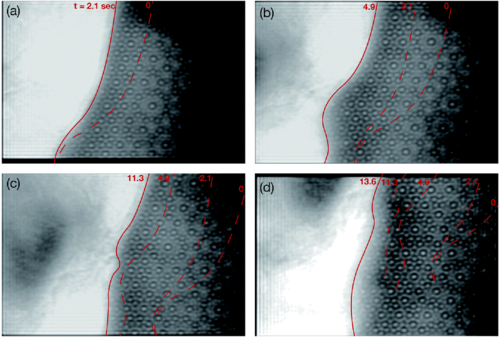(a)–(d) The HRTEM images at t=2.1, 4.9, 11.3, and 13.6 s, respectively, where the time was measured from the moment at which the image in Fig. 1 was taken. The positions of the growth front at t=0, 2.1, 4.9, 11.3, and 13.6 s are indicated by red curves in the figures. Credit: Phys. Rev. Lett. 115, 075501 – Published 10 August 2015. DOI: 10.1103/PhysRevLett.115.075501
(Phys.org)—A team of researchers with affiliations to the University of Tokyo and Tohoku University, both in Japan, have succeeded in filming the growth of a sample quasicrystal for the first time. In their paper published in Physical Review Letters, the team describes how they recorded the growth and their surprise at discovering a previously unknown error-correction mechanism that was part of the quasicrystal growth process.
Quasicrystals were discovered back in 1984 by Daniel Shechtman, who was awarded a Nobel Prize for his efforts—they are much like regular crystals except for one important detail, they repeat in a more complicated way. Regular crystals repeat in a cell structure over and over, resulting in a uniform lattice. Quasicrystals, on the other hand, grow in what are known as tiles, with the tiles repeating over and over. They have rotational symmetry, but not translational symmetry. Scientists have figured out how to grow quasicrystals and to use them in products, such as non-stick pans, but until now, the process by which they grow has not been understood. In this new effort, the team recorded the growth of a Al70.8Ni19.7Co9.5 quasicrystal at high speed, and when they played back what had been captured, were surprised to find that the crystal growth underwent an error-correction process.
After heating the sample to cause it to grow, the researchers saw that occasionally, a single atom from one grain would detach and join with another grain. The detaching and rejoining, the team found were a form of error-correction, allowing the crystal to grow with uniform tiles despite the occasional error during the growth process.
The finding by the team suggests that quasicrystals do not have long-range, nonlocal interactions as they grow, as some have suggested (to account for tile uniformity, rather than local uniformity) but instead appear to be governed by local interactions only—which comes as a relief to those in the field as there has been no explanation for how non-local interactions could have occurred. To explain why the error-correction process exits, the team with this new effort suggests that when errors occur, free energy in the quasicrystal is increased, but decreases again once the detaching atom joins another grain.
More information: Experimental Observation of Quasicrystal Growth, Phys. Rev. Lett. 115, 075501 – Published 10 August 2015. dx.doi.org/10.1103/PhysRevLett.115.075501
ABSTRACT
The growth of an Al-Ni-Co decagonal quasicrystal was observed by in situ, high-temperature, high-resolution transmission electron microscopy. The tiling patterns extracted from a series of high-resolution transmission electron microscopy images were analyzed on the basis of the high-dimensional description of quasicrystalline structures. The analyses indicated that the growth proceeded with frequent error-and-repair processes. The final, grown structure showed nearly perfect quasicrystalline order. Our observations suggest that the repair process by phason relaxation, rather than local growth rule, plays an essential role in the construction of ideal quasicrystalline order in real materials.
Journal information: Physical Review Letters
© 2015 Phys.org























